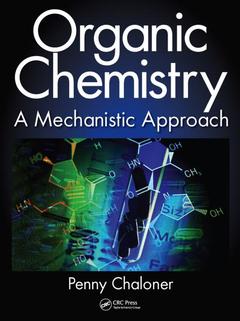Organic Chemistry A Mechanistic Approach
Auteur : Chaloner Penny

Offering a different, more engaging approach to teaching and learning, Organic Chemistry: A Mechanistic Approach classifies organic chemistry according to mechanism rather than by functional group. The book elicits an understanding of the material, by means of problem solving, instead of purely requiring memorization. The text enables a deep understanding of underlying principles that can be applied to a wide range of problems and systems. It also teaches a way of thinking and analysis that will serve students well across many academic disciplines.
Covering all the key aspects of organic chemistry, this text emphasizes the development of skills through a student-centered approach. In order to provide a contemporary feel to the subject, the author has included some of the more modern synthetic approaches. In addition, later chapters address the biological, environmental, industrial, and forensic aspects of organic chemistry.
Pedagogical Features:
- Extensive review problems, which are the central means of integrating the material
- "Focus boxes" that highlight key points in the chapters
- An instructors? website with full lecture notes in animated PowerPoint, a solutions manual in both Word and PowerPoint format, and additional problems for use in tests
A student website with solutions to review problems, and additional challenging problems and solutions for the ambitious, in animated PowerPoint and text versions
Introduction. Review of Atomic and Molecular Structure. Structure, Bonding and Nomenclature of Alkanes. Structure, Bonding and Nomenclature of Alkenes, Alkynes, Aromatic Compounds. Resonance Aromaticity. Structure, Bonding, Nomenclature of Heteroatom Containing Functional Groups. More Resonance. Chromatography, Mass spectrometry, UV and IR Spectroscopy. NMR Spectroscopy. Stereochemistry. Introduction to Mechanism. Nucleophilic Substitution. Elimination Reactions. Addition to Carbon-Carbon Multiple Bonds. Electrophilic Aromatic Substitution. Nucleophilic Aromatic Substitution, Synthesis of Aromatic Compounds, Polycyclic and Heterocyclic Compounds. Nucleophilic Addition to Carbonyl Groups. Nucleophilic Substitution at Carbonyl Groups. Lipids and Carbohydrates. Substitution α to Carbonyl Groups. Rearrangement Reactions. Multistep Synthesis 1 – Principles and One Group Disconnections. Multistep Synthesis 2 – Two Group Disconnections. Polymeric Materials. Amines, Alkaloids, Amino acids, Peptides, Nucleic Acids. Catalysis. Organic Chemistry in Industry. Organic Chemistry and the Environment. Introduction to Forensic Chemistry.
Date de parution : 11-2014
Ouvrage de 1284 p.
21x28 cm
Thèmes d’Organic Chemistry :
Mots-clés :
NMR Spectrum; Grignard Reagents; Review Of Atomic And Molecular Structure; NMR Spectroscopy; Structure; Bonding; Nomenclature Of Heteroatom Containing Functional Groups; Lone Pair; Nucleophilic Substitution; Ph Ph Ph Ph Ph; Structure; Bonding And Nomenclature Of Alkenes; Alkynes; Aromatic Compounds; Intramolecular Aldol Reaction; Introduction To Forensic Chemistry; Lithium Aluminum Hydride; Diels Alder Reaction; Pz Orbitals; Proton NMR Spectrum; Leaving Group; CO2Et CO2Et; Carbonyl Compounds; Friedel Crafts Reactions; Ph Ph Ph Ph; Aldol Reaction; Resonance Form; Carbon Oxygen Double Bond; Robinson Annulation; Sp2 Hybrid Orbitals; Silyl Enol Ether; Tetrahedral Intermediate; Sp2 Orbital; Fischer Projections; Electrophilic Substitution



